The figure above, showing a cooling trend in the United States, was posted by Steven Goddard (aka Tony Heller) on his blog with the remarkable title of "The Deplorable Climate Science Blog" (actually there is a slightly different one on the blog, right now, but it is simply a difference in the smoothing procedure). The author claims that this graphic is based on real data and that turns out to be true: but is it a honest graph?
The world is becoming more and more complicated. And the more complicated it is, the more difficult to understand it becomes. And there appear more and more opportunities to deceive people: we are all swamped by the news and have neither the competence nor the time to verify what the media serve to us.
So, this August, Mr. Tony Heller, writing under the pen name of Steven Goddard, published on his blog the graph you see above, showing a clear cooling trend in the United States. Make no mistake, these are real data, or so they are said to be. And they do show that summers have been cooling. But what about heat waves we are experiencing nowadays? Just an impression, apparently, because the data say otherwise. Then, what about global warming? An illusion, probably a fraud.
The graph is having a certain diffusion in the social media. An earlier version was even picked up by James Delingpole in his Breitbart news site. It quickly became a growing meme, scoffed or cheered depending on the attitude of the people commenting on it. As usual, the debate on climate on the social media is little more than a shouting match. It took some work by an expert, Tamino, on his "Open Mind" blog to dissect the story of this graph and show the tricks behind it. Tamino's whole post is reproduced below.
Basically, Steven Goddard's post is a textbook example of two well-known propaganda methods. Carlo Kopp describes the technique called "deception by omission" noting that it works when "the victim has poor a priori knowledge or no a priori knowledge or understanding of what the attacker is presenting to be a picture of reality" He also notes that deception by omission is often accompanied by "deception by spin" which consists in presenting only the information favorable to a certain viewpoint of a certain issue.
Note that neither deception by omission nor deception by spin require lying. It is all a way to present (or not to present) the data. This is what Goddard does, carefully choosing the data available on the NOAA site and presenting only those supporting the idea that the US has been cooling, not warming, during the past century or so. That's just not true, but the trick of these things is the ability to demonstrate a wrong thesis by using real data.
And that's what is truly impressive: how little it takes to deceive people. All that was needed to create a wholly new alternate reality was some patience and a high school level ability to manipulate data. No need for Goddard to be a government agent or to be paid by the PTB. All he needs is to be a lone troll with a stone ax to grind.
Now, stop for a moment and think: what if the real spooks were to engage in deceiving us for good? I mean, governments have resources and competencies in propaganda infinitely larger than those of a single person. What could they do to us if they were to direct us to a completely wrong perception of reality? Do you remember the story of the "weapons of mass destruction" at the time of Saddam Hussein? Now they can do much better than that. Yes, they can deceive us. And probably they do - they are doing that right now.
So, what's happening? The anthropologist Roy Rappaport spoke about "diabolical lies," defined as lies which tamper with the very fabric of truth. Maybe our whole civilization is being destroyed by lies, diabolical or not, and we desperately need a new epistemology to rebuild trust in our institutions and in ourselves as human beings. This is the task that the early Christian thinkers had engaged in at the time when another civilization, the Roman one, was being destroyed from inside by the very truths it had been built on - by then become diabolical lies. As Poul Anderson said, "all evil is rotten good" and that may well describe our situation.
At this point, I can only propose to you to read Tamino's post, below. At least, it clarifies a section of our perception of the universe.
___________________________________________________________________
USA Temperature: can I sucker you?
Suppose I wanted to convince people that temperature in the USA wasn’t going up, it was going down. What would I show? Let’s try yearly average temperature in the conterminous U.S., also known as the “lower 48 states” (I’ll just call it “USA”):
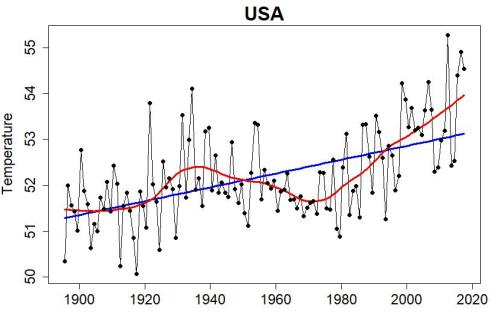
Well that won’t do. It shows that temperature has been rising, not falling. By the way, I’ve included two trend estimates. The blue straight line is a linear trend estimate and it’s going up. The red curvy line is a nonlinear trend estimate, it has gone up and down and up, and is now rising fast. Scary fast. That definitely won’t do.
But wait! The temperature shown is the mean temperature, which is the average of the high and low temperatures. What if I tried just low temperatures?
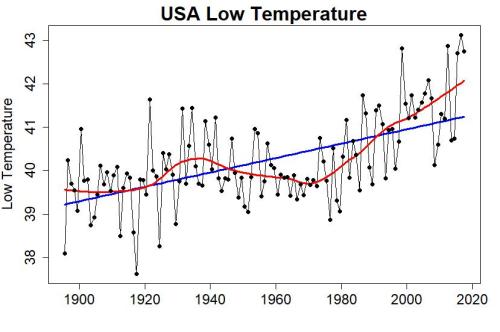
That won’t do either. Scary fast.
How about high temperatures?
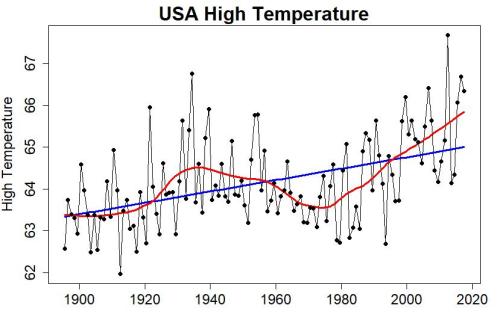
That still won’t do, but it’s a little better. There’s a more pronounced hump in the 1930s — that’s the dustbowl era. Could I maybe make the most of that?
Let’s try this: look at high temperature during the different seasons of the year. After all, we know winter has been warming faster than summer, maybe summertime only — or maybe at least one of the seasons — will give a more useful “sucker people” picture. Here are the average high temperatures for all four seasons separately:
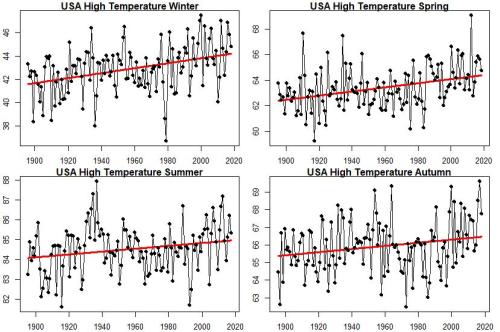
Now we’re getting somewhere! Summer high temperature has still been increasing overall, but that hump during the 1930s (the dust bowl era) is far more pronounced. Maybe I could make something of that?
Perhaps I could just get rid of some of the data I don’t like. I can’t get rid of the most recent stuff — then people will figure out I’m trying to sucker them. How about I get rid of some of the early stuff? I’ll start with 1918, instead of starting when the data actually start (1895). That leaves this:
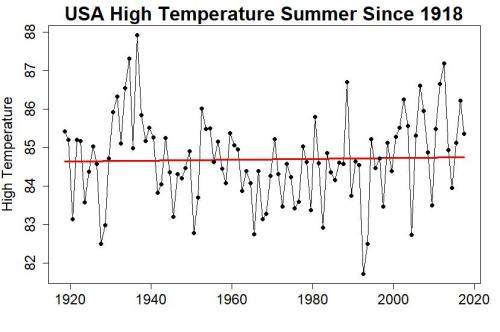
Finally! I’ve got a graph that looks like there’s nothing to worry about, where the linear trend is so small you almost can’t tell it’s still (barely) rising, and I only had to pick one of 12 possible combinations (mean/high/low temperature over winter/spring/summer/autumn) and leave out the early data to get it. Clever.
Even so, the trend is still going up even if just barely. And that’s the linear trend; the nonlinear trend looks like it might be rising noticeably lately, maybe even getting close to as hot as the summer of the dust bowl era. Could I fix that?
Of course I can! Instead of using the USA temperature data from the “experts,” those people at NOAA (the National Oceanic and Atmospheric Administration) who think they’re so good at it just because they’ve spent decades studying all that “math” and learning how to do it “right,” I’ll just take the raw data and form a simple average. Those NOAA people will tell you that isn’t right, that over the years new stations have come online and old ones have retired so you have to take that into account. They’ll talk about fancy-schmancy math stuff like “area weighting.” That’s all just NOAA tricks, aren’t they just a bunch of frauds? We can completely ignore the fact that over the years the average location of all the contributing stations has moved slightly northward to colder territory:
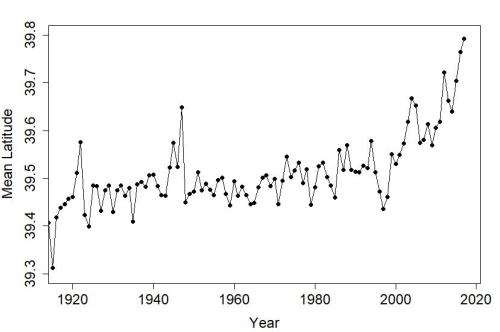
Heck we can completely ignore everything that they’ve learned about how to do it right … mainly because if we just take a simple, naive average we’ll get what we want.
There’s a graph going around the internet from Steve Goddard a.k.a. Tony Heller, claiming to show that temperature in the U.S. has been declining, using only high temperatures, using only summertime temperatures, using only data since 1918, based on a simple average without taking into account new stations coming online or old stations retiring or area-weighting or any of that “expert” stuff:
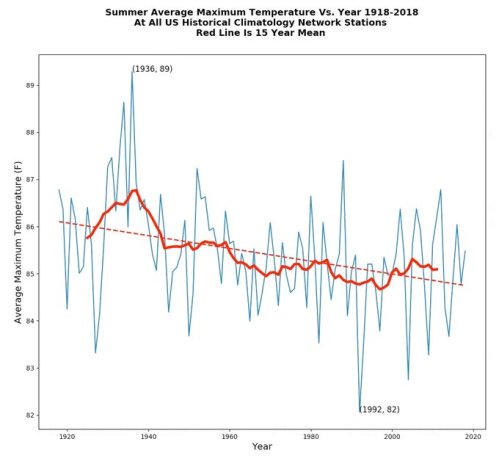
Imagine that.
